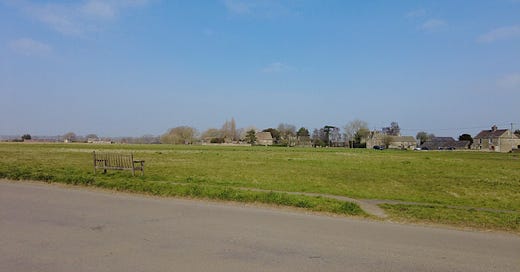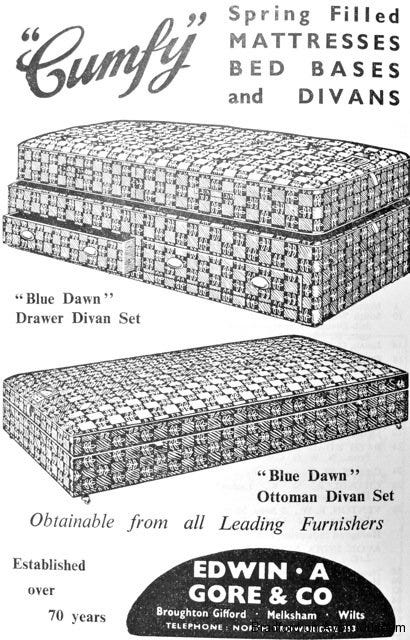Every village has a story to tell. They all have their differences and similarities. You join me in this story in the Wiltshire village of Broughton Gifford. You will see that it has a large common which itself has stories to tell.
The village name most likely comes from the brook that flows near the church. The Broughton part could derive from broc-tun meaning farm on the brook. The Gifford part takes its name from the Giffard family (with an ‘a’) who were former owners of the village 1268-1338.
Broughton Gifford lies close to Melksham and the village of Holt. It’s been inhabited for a long time and was in the King’s hands at the time of the Domesday Book, 1086 and therefore must have existed before this date.
Much of the surrounding area was woodland which was greatly felled during both the First and Second World Wars. A railway line passes by the village and until 1955 a halt was in existence for almost fifty years.
I am starting my tour of the village at the Common. The size of the common land is large compared the population of approximately one thousand. There is no need for a coat this afternoon as Britain is having a lovely sunny period.
The Common is triangular and consists of twenty-eight acres. It survived the inclosure act. Records show that in 1798 a petition was signed against its inclosure. In 1951, the Lord of the Manor, Sir Charles Hobhouse donated the Common to the Parish Council. Common land gives rights to certain people to graze their animals. often those living around a common. Today, few take advantage of this this, but, if they wish to, grazing is limited from August 13th to October 26th each year.
The Common, in the past, was known for being a marshy area. An early eighteenth-century reference called it Broughton Marsh. It was thought of as an unhealthy place to live. Attempts have been made to drain it, the last around 1970. There are a number of ponds, although, probably fewer than in the past.
During the Second World War, the army were on the land to defend it case the Germans wanted to use it as a landing area. It’s said the troops had great fun driving their vehicles through the wet areas. Off-roading can be fun!
The surface of the ground is marked by earthworks. Some interpreted these as the remnants of a deserted medieval village, but there is no documentary evidence to substantiate this. In 2020, Bradford on Avon Museum carried out tests and found nothing to indicate this area had been a village. The earthworks are possibly a Roman field system.
This Common is surrounded by houses, the majority not much earlier than the late eighteenth-century. Some might stand on the sites of earlier homes, it’s not possible to tell.
There are some lovely buildings around the common land and here are some to consider.
Gifford Hall dates from around 1700 and was built for the Harding Family. It is constructed from Limestone Ashlar and has six bedrooms according to a property website and it was last sold in 2010 for £2.3 million.
Broughton House, a farmhouse, the central part with gables dates to 1673 and has eighteenth-century extensions to each side.
In 1806, the Particular Baptists built their chapel facing onto the common. A Sunday school was added to the rear in 1830. Opening the metal gate and walking around, there is a lot of family history lying in the graveyard. It’s the final resting place of well-known locals with family names still living on in the village today. The building is still an active Baptist church.
To the right of the church is a Scouts Hall and next door is the village bowls club, with its green looking like a well made carpet. For the thirsty walker you are in sight of the The Bell on the Common sited alongside the road which passes on the edge of The Common. It appears that the pub was once three houses of different dates. It has a long history and at least part of it existed as records show an auction of a farm here. A certain, Thomas Brown held the auction.
In 1789, The Bell was acquired by Sir Benjamin Hobhouse when he purchased the manor. It remained in his family until sold in 1957 to the Devizes brewery, Wadworth.1
Fun fact: Broughton Gifford was once known for its cheese and geese. This led to locals having the nickname, Ganders.
Having completed my walk around the perimeter of the 28-acre common, I now head toward The Street, a long road running through linear part of the village. The Street has an eclectic mix of old and new buildings and I will share some of these with you.
There has been some additional housing built in the 1960s such as Newleaze Park and Curtis Orchard. Along The Street itself, the first house I come to is the very imposing Hollybrook House which along with many other buildings is listed to protect it from development along with its gate and railings. Many homes lost their railings during the Second World War when they were taken to be melted down for use in the war effort.
It is a Georgian house of three bays and three floors, with two-storey single bays on each side. It is all faced in ashlar; only the left side wing, a 19th century addition to match the other side, has a stone-tiled roof. The façade to the street is actually a late-Georgian refronting of an earlier 18th century house.
Moving along the road there is a small brook and I reach a cobblestoned area of the footpath not covered over by the ubiquitous black tarmac. If only the rest of the footpath were the same! I am now at the former Methodist Church built in 1907 and now converted to a private home.
There is a small industrial site in the village, which having spoken to a delivery driver who had driven past it twice and couldn’t see it, is well-hidden. The entrance appears nothing more than a wide driveway leading to a house and a lack of signs would fool anyone. The site was once a sawmills and a bed factory, E.A. Gore was here until it was wound up in 1966. Sadly, this was after more than eighty years of bed manufacture in the village.
The Reading Room is next. This was built in 1828 and today is used for holiday accommodation.
Broughton Gifford’s other public house soon comes into view, lying on a bend in the road. It’s the Fox and Hounds. Like The Bell on The Common it too appears to have once been three houses. It’s been functioning as a pub since at least 1855 when Skreen White was listed as a beer seller. It was re-opened in October 2022 having been closed for five years.
Further along The Street the road bends sharply to the right and a junction into Mill Lane is ahead. The beauty here, though, is on my left. Facing the changed direction of The Street I can see the magnificent Manor House.
Dated 1622 and The Manor House was built for Sir John Horton. It became divided into two, but was restored by a Mr Schmidt around 1909. In the early 20th century it was a home of the playwright Clifford Bax (1886-1962), brother of the composer Arnold Bax.
There has been a school in Broughton Gifford since 1782 when a charity school was established with money donated by Francis and Betty Paradice. St Mary’s School now stands on the same site and was built in 1853 thanks to a grant from the Anglican National Schools Society. The school has been extended over the years, notably in 1872, 1893, 1974 and 2016. The grounds were extended in 1959 with the purchase of a field to the rear of the school. I am in time to get a photo before the children are due to come out.
Passing the school I now reach the former Rectory which is now a care home. This replaced an earlier building on the site. It’s actually larger than the church! It was designed by Thomas Henry Wyatt for the Reverend John Wilkinson and built between 1849-1852. It was sold in 1974.
Next door as you would expect is the church, St. Mary’s. It stands on a low hill giving it a slight elevation. The church has been here a very long time. A charter of King John in 1200 confirms that Shaftesbury Abbey was in possession of the chapel of Broctone with its lands and tithes, given by Gundrada with her kinswoman, Albreda de Bosco Roaldae maybe a century earlier.
The body of the church is 13th century and the battlement west tower is in the 15th century perpendicular style. A south chapel was added in the 13th century and next to it the south porch which when built had an upper room.
The church had to be restored in 1850 and further work in 1878 when the north aisle was extended eastward. The east chancel window was added at that time. Opposite the church is the village cemetery
In the churchyard, with many old graves, lies another piece of history. The base and part of the shaft of a cross from the 12th century lies near the entrance footpath. If anyone wishes to trace their family tree, the parish registers date back as far as 1665.
I complete my walk upon reaching the bridge across the brook that likely gives Broughton Gifford part of its name. Parsonage Bridge in 1624 was described as ‘newly built and not thoroughly finished’. It replaced an older bridge that was in need of repair in 1568. Today it is still able to take the weight of vehicles passing over to and fro and that’s a great testimony to the designer and builders. Many bridges built in the last hundred years have needed to be replaced.
This has been a wonderful walk on a beautiful spring day in late March. I hope you have enjoyed this tour. If you have, please click on the like button. If you’re not a subscriber yet, please do click the button and join me, free or paid.
You can also support Roland’s Travels using Buy Me a Coffee




















What a beautiful part of the country! I enjoyed your virtual tour, Roland. It's fascinating to hear how things have changed over the years.